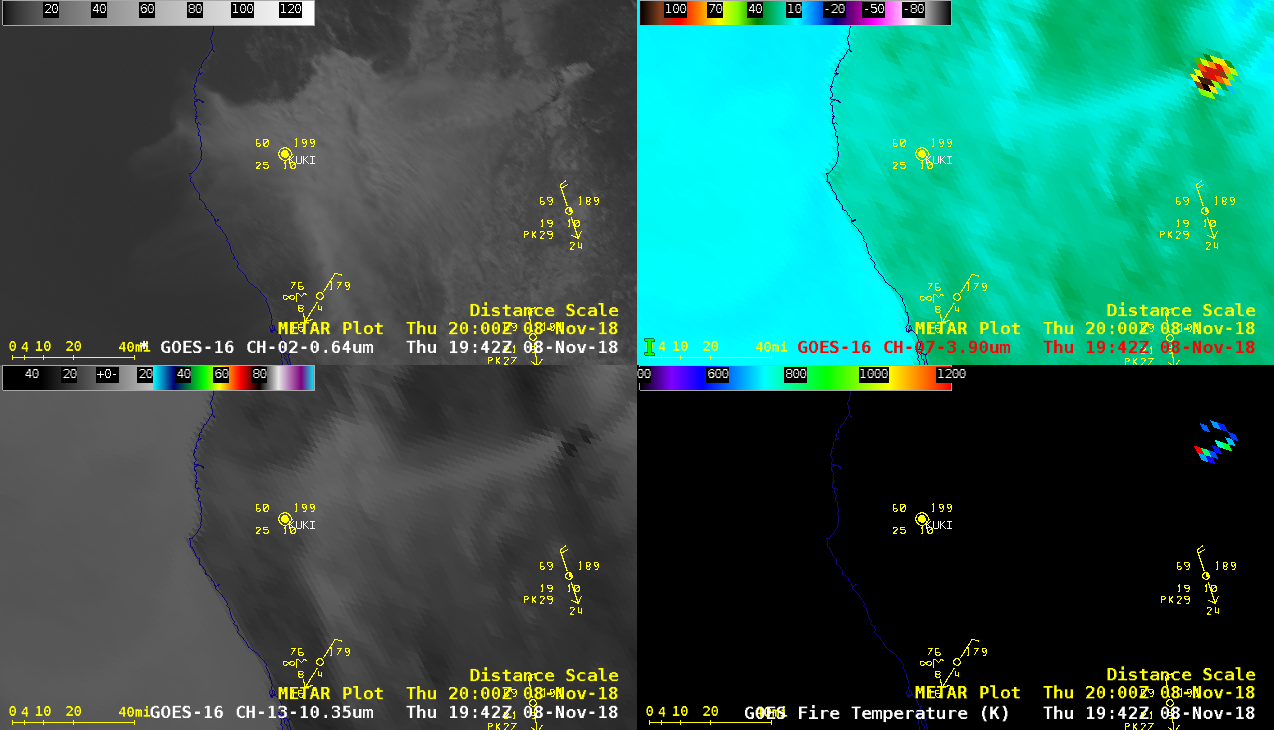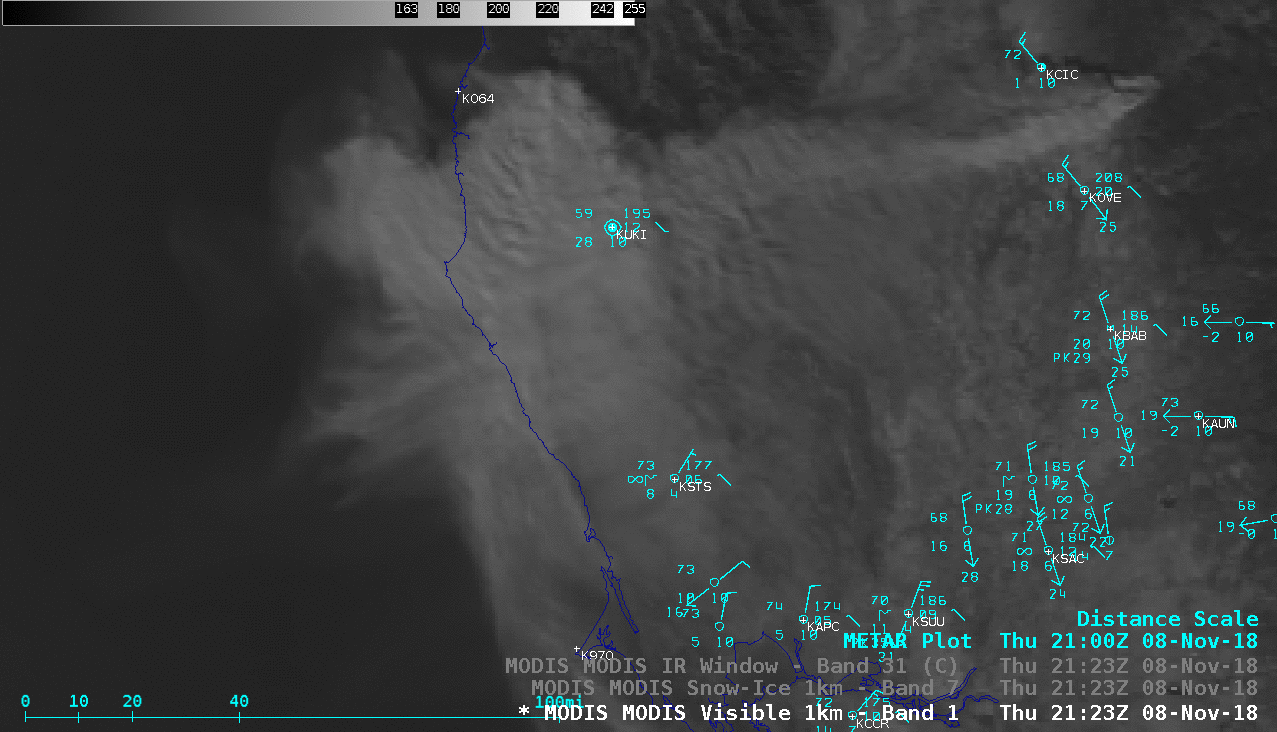Camp Fire in northern California

GOES-16 “Red” Visible (0.64 µm, top left), Shortwave Infrared (3.9 µm, top right), “Clean” Infrared Window (10.3 µm, bottom left) and Fire Temperature (bottom right) [click to play animation | MP4]
A GOES-16 Mesoscale Domain Sector was positioned over California beginning at 2115 UTC, providing imagery at 1-minute intervals — a comparison of Visible and Shortwave Infrared images (below) showed how quickly the hot thermal signature of the fire (yellow to red enhancement) advanced southwestward during the remaining 3 hours of daylight. Just northwest of the fire, Chico (station identifier KCIC) reported very low relative humidity values (6% at 21 UTC), as seen by the large spread between temperature and dewpoint late in the day.
GOES-16 “Red” Visible (0.64 µm, left) and Shortwave Infrared (3.9 µm, right) images [click to play MP4 animation]
![NOAA-18 AVHRR Visible (0.64 µm), Near-Infrared "Vegetation" (0.86 µm), Shortwave Infrared (3.7 µm) and Infrared Window (10.8 µµ) images [click to enlarge]](https://cimss.ssec.wisc.edu/satellite-blog/wp-content/uploads/sites/5/2018/11/181108_1712utc_noaa18_visible_vegetation_shortwaveInfrared_infraredWindow_Camp_Fire_CA_anim.gif)
NOAA-18 AVHRR Visible (0.64 µm), Near-Infrared “Vegetation” (0.86 µm), Shortwave Infrared (3.7 µm) and Infrared Window (10.8 µm) images [click to enlarge]

NOAA-20 VIIRS Visible (0.64 µm), Near-Infrared “Snow/Ice” (1.61 µm) and Infrared Window (11.45 µm) images [click to enlarge]

Aqua MODIS Visible (0.65 µm), Near-Infrared “Snow/Ice” (1.61 µm) and Infrared Window (11.0 µm) images [click to enlarge]
![NOAA-20 Visible (0.64 µm), Day/Night Band (0.7 µm), Near-Infrared "Snow/Ice" (1.61 µm), Shortwave Infrared (3.74 µm) and Infrared Window (11.45 µm) images [click to enlarge]](https://cimss.ssec.wisc.edu/satellite-blog/wp-content/uploads/sites/5/2018/11/181108_2037utc_noaa20_viirs_visible_dayNightBand_snowIce_shortwaveInfrared_infraredWindow_Camp_Fire_CA_anim.gif)
NOAA-20 Visible (0.64 µm), Day/Night Band (0.7 µm), Near-Infrared “Snow/Ice” (1.61 µm), Shortwave Infrared (3.74 µm) and Infrared Window (11.45 µm) images [click to enlarge]
![Aqua MODIS Visible (0.65 µm), Near-Infrared "Cirrus" (1.37 µm), Near-Infrared "Snow/Ice" (1.61 µm), Shortwave Infrared (3.7 µm) and Infrared Window (11.0 µm) images [click to enlarge]](https://cimss.ssec.wisc.edu/satellite-blog/wp-content/uploads/sites/5/2018/11/181108_2123utc_aqua_modis_visible_cirrus_snowIce_shortwaveInfrared_infraredWindow_Camp_Fire_CA_anim.gif)
Aqua MODIS Visible (0.65 µm), Near-Infrared “Cirrus” (1.37 µm), Near-Infrared “Snow/Ice” (1.61 µm), Shortwave Infrared (3.7 µm) and Infrared Window (11.0 µm) images [click to enlarge]
Record dry airmass over our region today. The 00Z Oakland Sounding from this afternoon reported a precipitable water value of only 0.12″. This is well below the record for the date of 0.24″ and one of the all-time driest soundings at Oakland in more than 60 years. #CAwx pic.twitter.com/Ohtg5mvsQO
— NWS Bay Area (@NWSBayArea) November 9, 2018
The Aqua MODIS Total Precipitable Water product at 2123 UTC (below) showed widespread values in the 3-5 mm range (darker shades of brown) over much or northern California. 12 hours later, the TPW value from the 12 UTC Oakland sounding was slightly lower (2.9 mm or 0.11 inch) — and the MODIS TPW product at 0921 UTC continued to show widespread dry air over California.
![Aqua MODIS Total Precipitable Water product and Visible (0.65 µm) image at 2123 UTC [click to enlarge]](https://cimss.ssec.wisc.edu/satellite-blog/wp-content/uploads/sites/5/2018/11/181108_2123utc_modis_totalPrecipitableWater_visible_NorCal_anim.gif)
Aqua MODIS Total Precipitable Water product and Visible (0.65 µm) image at 2123 UTC [click to enlarge]
NOAA-15 AVHRR Shortwave Infrared (3.7 µm) image; major highways are plotted in cyan, with Interstate highways plotted in red [click to enlarge]
===== 09 November Update =====
Nighttime VIIRS Day/Night Band (0.7 µm) and Shortwave Infrared (3.74 µm) images from NOAA-20 at 0849 UTC (above) and Suomi NPP at 0942 UTC (below) revealed the bright glow and the large, hot thermal anomaly of the Camp Fire. VIIRS True Color RGB images from Suomi NPP at 2104 UTC and NOAA-20 at 2154 UTC (below) showed the broad extent of the smoke from the Camp Fire in northern California as well as the Woolsey Fire in southern California. These images were captured and processed by the CIMSS/SSEC Direct Broadcast ground station. An animation of 1-minute GOES-16 Visible and Shortwave Infrared images (below) revealed several plume jumps over the fire source from 15-19 UTC — and toward the end of the day, a decrease in the areal coverage and intensity of hot pixels indicated that extreme fire conditions were easing and containment efforts were slowing the spread of the fire.GOES-16 “Red” Visible (0.64 µm, left) and Shortwave Infrared (3.9 µm, right) images [click to play MP4 animation]
Paradise, CA has only seen 0.88″ of rain since May 1st. The Average rainfall between May 1st & Oct 31st is 7.13″! This is the conditions that have lead to a absolutely horrific fire known as the #CampFire #CAwx #CalFire #CaliforniaFires pic.twitter.com/CcvsMeogNq
— James Sinko (@JamesSinko) November 9, 2018
====== 11 November Update =====
A sequence of Suomi NPP VIIRS Shortwave Infrared (3.74 µm) images centered at Paradise, California viewed using RealEarth (above) showed the spread of the Camp Fire thermal anomaly (dark black pixels) during the period 1943 UTC on 08 November to 1046 UTC on 11 November.1-minute GOES-16 Visible and Shortwave Infrared images (below) showed the development of new smoke plume and hot thermal signatures around the periphery of the ongoing Camp Fire during the day on 11 November. As of 1849 UTC (10:49 AM local time), the fire had burned 109,000 acres and was listed as 25% contained.
GOES-16 “Red” Visible (0.64 µm, left) and Shortwave Infrared (3.9 µm, right) images [click to play MP4 animation]


![NOAA-20 VIIRS True Color RGB image [click to enlarge]](https://cimss.ssec.wisc.edu/satellite-blog/wp-content/uploads/sites/5/2018/11/181108_2036utc_noaa20_viirs_truecolor_Camp_Fire_CA.jpg)
![NOAA-20 VIIRS Day/Night Band (0.7 µm) and Shortwave Infrared (3.74 µm) images [click to enlarge]](https://cimss.ssec.wisc.edu/satellite-blog/wp-content/uploads/sites/5/2018/11/181109_0849utc_noaa20_viirs_dayNightBand_shortwaveInfrared_Camp_Fire_CA_anim.gif)
![Suomi NPP VIIRS Day/Night Band (0.7 µm) and Shortwave Infrared (3.74 µm) images [click to enlarge]](https://cimss.ssec.wisc.edu/satellite-blog/wp-content/uploads/sites/5/2018/11/181109_0942utc_suomiNPP_viirs_dayNightBand_shortwaveInfrared_Camp_Fire_CA_anim.gif)
![Suomi NPP VIIRS True Color RGB image at 2104 UTC [click to enlarge]](https://cimss.ssec.wisc.edu/satellite-blog/wp-content/uploads/sites/5/2018/11/181109_2104utc_suomiNPP_viirs_truecolor_CalFires_smoke.jpg)
![NOAA-20 VIIRS True Color RGB image at 2154 UTC [click to enlarge]](https://cimss.ssec.wisc.edu/satellite-blog/wp-content/uploads/sites/5/2018/11/181109_2154utc_noaa20_viirs_truecolor_CalFires_smoke.jpg)
![US Drought Monitor conditions as of 06 November [click to enlarge]](https://cimss.ssec.wisc.edu/satellite-blog/wp-content/uploads/sites/5/2018/11/181106_CA_drought_monitor.png)
![Suomi NPP VIIRS Shortwave Infrared (3.74 µm) images [click to play animation]](https://cimss.ssec.wisc.edu/satellite-blog/wp-content/uploads/sites/5/2018/11/181108_1943utc_viirs_swir_camp.jpg)
![Suomi NPP VIIRS True Color RGB image at 2029 UTC [click to enlarge]](https://cimss.ssec.wisc.edu/satellite-blog/wp-content/uploads/sites/5/2018/11/181111_2029utc_suomiNPP_viirs_truecolor_NorCal.jpg)
![NOAA-20 VIIRS True Color RGB image at 2114 UTC [click to enlarge]](https://cimss.ssec.wisc.edu/satellite-blog/wp-content/uploads/sites/5/2018/11/181111_2114utc_noaa20_viirs_truecolor_NorCal.jpg)